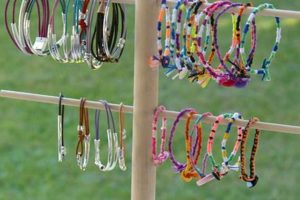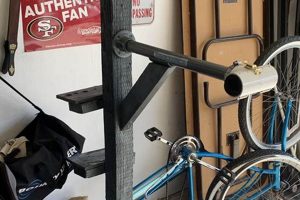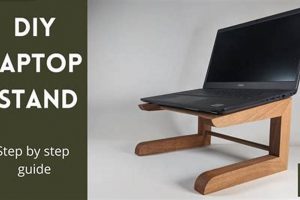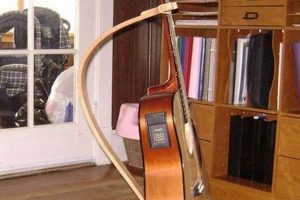A self-constructed entertainment center, primarily composed of lumber, designed to support a television is a prevalent project among woodworking enthusiasts. These units offer a customized solution for media storage and display, adaptable to various aesthetic preferences and spatial constraints. An example would be a homeowner building a rustic-style console from reclaimed barn wood to house their television and related electronics.
The appeal of crafting such a piece lies in its cost-effectiveness, personalization, and the satisfaction derived from a hands-on endeavor. Historically, individuals have fashioned their own furniture to meet specific needs and budget limitations. The contemporary resurgence of this practice reflects a desire for unique, sustainable pieces that diverge from mass-produced alternatives, often incorporating repurposed or locally sourced materials. The benefits extend beyond mere functionality to encompass creative expression and environmental consciousness.
The following sections will delve into design considerations, material selection, construction techniques, and finishing options for creating a durable and visually appealing entertainment center. Subsequent discussions will address common challenges encountered during the building process and offer practical solutions for achieving professional-quality results.
Essential Considerations for Entertainment Center Construction
The following tips provide guidance on key aspects of designing and building a television support structure from wood. Adhering to these recommendations will contribute to a more successful and satisfying construction experience.
Tip 1: Precise Measurements and Planning: Before commencing construction, meticulous measurement of the intended space and television dimensions is crucial. Develop a detailed plan outlining dimensions, shelf placement, and cable management solutions. Neglecting this step can lead to a final product that is ill-fitting or functionally inadequate.
Tip 2: Material Selection Based on Load: Choose lumber appropriate for supporting the weight of the television and associated components. Solid wood offers superior strength and durability compared to composite materials. Consider species like oak or maple for heavy loads, while pine may suffice for lighter televisions.
Tip 3: Prioritize Structural Integrity: Employ robust joinery techniques such as mortise and tenon, dovetail, or pocket screws to ensure structural stability. Weak joints can compromise the safety of the unit and lead to premature failure. Reinforce corners with brackets or gussets for added strength.
Tip 4: Cable Management Integration: Design the unit to incorporate effective cable management solutions. Drill strategically placed holes for routing cables and consider installing a back panel to conceal wiring. This enhances the aesthetic appeal and prevents tangled wires.
Tip 5: Consider Ventilation Requirements: Electronic devices generate heat. Design the unit to allow for adequate ventilation to prevent overheating and prolong the lifespan of the equipment. Open shelves or ventilation holes in the back panel can facilitate airflow.
Tip 6: Apply a Durable Finish: Protect the wood with a durable finish that resists scratches, moisture, and UV damage. Consider a polyurethane or varnish finish for optimal protection. Apply multiple coats and allow sufficient drying time between applications.
Tip 7: Hardware Selection: Use high-quality hardware for hinges, drawer slides, and knobs. Inferior hardware can detract from the overall appearance and functionality of the piece. Match the hardware to the style and finish of the wood for a cohesive look.
Adherence to these suggestions will increase the likelihood of creating a durable, functional, and aesthetically pleasing support structure. Prioritizing planning, material selection, and structural integrity are paramount for a successful outcome.
The following section will present a step-by-step construction guide, outlining the essential tools and techniques required for assembling the entertainment center.
1. Wood type selection
The selection of wood is a foundational decision in the creation of a self-constructed television support structure, directly influencing its structural integrity, aesthetic qualities, and overall longevity. Careful consideration of different wood species is therefore paramount.
- Hardwood vs. Softwood
Hardwoods, such as oak, maple, and cherry, offer superior strength and resistance to dents and scratches, making them suitable for supporting heavier televisions and enduring daily use. However, they tend to be more expensive and require more specialized tools for cutting and shaping. Softwoods, like pine, fir, and cedar, are more affordable and easier to work with, but are less durable and prone to damage. Their use is typically limited to lighter televisions or components where aesthetic appeal outweighs the need for robustness.
- Grain Pattern and Aesthetic Appeal
The grain pattern and natural color of the wood significantly contribute to the overall aesthetic of the finished entertainment center. Each wood species possesses unique visual characteristics. Oak exhibits a prominent, open grain, while maple has a tighter, more uniform grain. Cherry features a rich, reddish-brown hue that deepens with age. The selection should align with the desired style, whether it be rustic, modern, or traditional. Careful matching of grain patterns across different components enhances visual harmony.
- Workability and Tooling Requirements
Different wood species vary in their workability, affecting the ease with which they can be cut, shaped, and joined. Softwoods are generally easier to work with using hand tools, while hardwoods may require power tools for efficient processing. Some hardwoods can be prone to tear-out during machining, necessitating the use of sharp blades and appropriate cutting techniques. The choice of wood should be informed by the builder’s skill level and the available tools.
- Cost and Availability
The cost and availability of different wood species can vary significantly depending on geographic location and market conditions. Exotic hardwoods are typically more expensive and harder to source than domestic species. Using locally sourced lumber can reduce costs and minimize environmental impact. Consideration of budget constraints and accessibility is essential for making a practical and sustainable wood selection.
The optimal wood selection for a self-made television support structure represents a compromise between structural requirements, aesthetic preferences, workability, and budgetary limitations. By carefully evaluating these factors, a builder can create a piece that is both functional and visually appealing, reflecting their individual style and craftsmanship.
2. Design and Measurements
Precise design and accurate measurements are paramount in the successful construction of a wooden, self-assembled television support structure. These elements dictate the functionality, aesthetics, and structural integrity of the final product. Neglecting this initial phase can lead to dimensional inaccuracies, instability, and an overall unsatisfactory outcome.
- Spatial Requirements and Television Dimensions
Accurate assessment of the available space and the precise dimensions of the television are critical. The width, depth, and height of the intended structure must accommodate the television with adequate clearance for ventilation and cable management. Overlooking these spatial considerations may result in a television stand that is either too large, dominating the room, or too small, compromising stability and visual harmony. Example: A television with a 55-inch screen requires a stand that is at least as wide as the screen and deep enough to prevent tipping.
- Load-Bearing Capacity and Structural Calculations
The design must incorporate calculations to ensure the structure can safely support the weight of the television and any associated components, such as DVD players, gaming consoles, or sound systems. The thickness and type of wood, as well as the chosen joinery methods, must be sufficient to withstand the anticipated load. Failure to account for load-bearing capacity can lead to structural failure and potential damage to the television. Example: A solid oak top with appropriate support framing is necessary for a large, heavy television.
- Ergonomics and Viewing Angle
The height of the television stand must be designed to ensure an optimal viewing angle, minimizing strain on the neck and eyes. The ideal viewing height typically places the center of the television screen at eye level when seated. Inaccurate height calculations can lead to discomfort and a compromised viewing experience. Example: Measuring the seated eye height and calculating the necessary stand height to achieve optimal viewing is essential.
- Aesthetic Integration and Proportionality
The design should consider the aesthetic integration of the television stand with the surrounding dcor. The style, color, and proportions of the stand should complement the existing furniture and architectural elements of the room. Disproportionate dimensions or a clashing aesthetic can detract from the overall visual appeal of the space. Example: A minimalist design with clean lines and a neutral finish may be appropriate for a modern living room.
The preceding facets demonstrate that design and measurements constitute a critical foundation for a successful woodworking project. Accurately accounting for these elements contributes to a final product that is structurally sound, ergonomically optimized, and aesthetically pleasing. The integration of these considerations ensures the longevity and satisfaction derived from the self-constructed entertainment center. Further refinement of these principles facilitates a cohesive and functional integration of the furniture piece into the designated living space.
3. Joinery Techniques
Joinery techniques are fundamental to the construction of a durable and aesthetically pleasing entertainment center. The selection and execution of these techniques directly influence the structural integrity, stability, and overall lifespan of the self-made television support structure.
- Mortise and Tenon Joints
Mortise and tenon joints, characterized by a projecting tenon inserted into a mortise (a cavity), provide exceptional strength and resistance to racking forces. In the context of television support construction, these joints are particularly suitable for connecting legs to the top surface or for framing elements that bear significant weight. An example is using mortise and tenon joints to secure the vertical supports to the horizontal shelves of the entertainment center. Improper execution can lead to joint failure under load.
- Dovetail Joints
Dovetail joints, recognized by their interlocking, fan-shaped tenons, offer superior resistance to tensile forces and are often used in drawer construction. While perhaps not essential for the primary structure of the television stand itself, dovetail joints enhance the quality and longevity of any drawers incorporated into the design. An instance is utilizing dovetail joints to assemble the drawer boxes that house media components. Sloppy dovetails compromise the structural integrity of the drawer.
- Pocket Screw Joints
Pocket screw joints, employing angled screws driven into pre-drilled pockets, offer a relatively simple and fast method for joining wood components. These joints are suitable for less critical structural elements, such as attaching face frames or assembling cabinet carcasses. An example is using pocket screws to attach the side panels to the top and bottom boards of the television stand. Over-reliance on pocket screws in load-bearing areas can weaken the overall structure.
- Butt Joints with Reinforcement
Butt joints, where two pieces of wood are joined end-to-end, represent the simplest form of joinery but lack inherent strength. To compensate for this, butt joints must be reinforced with fasteners such as screws, dowels, or biscuits, or with adhesive. An example is using butt joints, reinforced with screws and glue, to attach a back panel to the entertainment center for added stability. Inadequate reinforcement can lead to joint separation and structural instability.
The selection of appropriate joinery techniques is a crucial determinant of the structural soundness and visual appeal of any entertainment center. While each technique offers distinct advantages and limitations, the correct application, with diligent execution, is vital to its success. Attention to detail in the creation of these joints ensures that the resulting structure is not only visually pleasing, but also capable of withstanding the demands of everyday use for an extended period.
4. Cable Management
Effective cable management is an indispensable component of a self-constructed wooden television support structure. The proliferation of electronic devices associated with modern entertainment systems necessitates a thoughtful strategy for concealing and organizing the numerous power cords, signal cables, and interconnects. Untamed cables create visual clutter, pose tripping hazards, and impede access to components for maintenance or reconfiguration. Consequently, the design and construction of a support must integrate solutions to mitigate these issues. For example, strategically placed grommets and access holes allow for the routing of cables from the rear of components to power outlets without exposing them to view. Similarly, internal channels or concealed compartments can house excess cable length, maintaining a tidy aesthetic.
The integration of cable management features is not merely an aesthetic consideration, but also a practical one. Accessible and organized cables facilitate troubleshooting and system upgrades. Labeling cables near connection points proves beneficial when disconnecting and reconnecting components. Furthermore, the separation of power and signal cables minimizes electromagnetic interference, potentially improving audio and video quality. Real-world examples include incorporating a dedicated channel behind the television stand to route power cords away from audio cables, or using Velcro straps to bundle and organize cables within an enclosed compartment. These strategies enhance functionality and preserve the integrity of the entertainment experience.
In summary, the successful design and construction of a wooden television support structure hinges on the effective integration of cable management solutions. These solutions, ranging from simple grommets to complex internal routing systems, contribute significantly to the aesthetic appeal, functionality, and maintainability of the finished product. Failure to address cable management during the design phase often results in an unsightly and disorganized entertainment setup, undermining the value and enjoyment of the self-constructed unit. Prioritizing cable management from the outset yields a more professional, user-friendly, and visually appealing outcome.
5. Finishing Applications
The application of a suitable finish is a critical final stage in the construction of a wooden, self-assembled television support structure. This process extends beyond mere aesthetic enhancement, impacting the long-term durability, resistance to environmental factors, and overall value of the finished product. The selection of a compatible finish is dependent on factors such as the type of wood used, the intended aesthetic, and the expected level of wear and tear. Without proper finishing, the wood is vulnerable to moisture absorption, scratches, UV degradation, and potential insect infestation. For example, a pine entertainment center left unfinished in a humid environment will likely warp and develop mold, whereas a properly finished unit will remain stable and aesthetically pleasing.
Various finishing options are available, each offering distinct characteristics and application requirements. Polyurethane provides a durable, water-resistant surface ideal for high-traffic areas, while varnish offers a classic sheen and good protection against scratches. Oil-based finishes enhance the natural grain of the wood but require more maintenance. Water-based finishes are environmentally friendly and dry quickly but may not offer the same level of durability as solvent-based options. Real-world applications include applying multiple coats of polyurethane to a frequently used entertainment center to prevent damage from spills and scratches, or using a penetrating oil finish on a rustic-style stand to accentuate the wood’s natural texture. Failure to properly prepare the surface before applying the finish, or using an incompatible product, can result in adhesion problems, uneven coloring, and premature failure of the finish.
In summary, the selection and application of an appropriate finish are essential for realizing the full potential of a wooden, self-constructed television support. This final step not only enhances the visual appeal but also safeguards the underlying wood from environmental damage and wear, ensuring the longevity and value of the finished product. The informed selection and meticulous application of the chosen finish represent a worthwhile investment of time and effort, contributing significantly to the overall success of the woodworking endeavor. The careful selection should take into consideration the wood species used, the desired visual effect, and the environmental conditions to which the piece will be exposed.
6. Weight capacity
The weight capacity of a self-constructed wooden television support structure is a critical design parameter directly impacting its safety and longevity. It represents the maximum load the structure can bear without experiencing structural failure or compromising its intended function. The weight capacity must be determined through careful consideration of the materials used, joinery methods employed, and the anticipated load, which includes the television itself and any accompanying electronic devices or decorative items. Failure to accurately assess and accommodate the necessary weight capacity can result in catastrophic collapse, potentially damaging the television and posing a safety hazard. A practical example illustrates this principle: a television support built from lightweight pine using butt joints secured only with screws would likely lack the weight capacity to safely support a large, modern television, leading to structural instability and eventual failure.
Calculating the required weight capacity involves considering the combined weight of all items intended for placement on the structure. This includes the television’s weight as specified by the manufacturer, as well as the weight of any DVD players, gaming consoles, sound systems, or decorative objects. It is prudent to incorporate a safety margin, typically a factor of 1.5 to 2, to account for unforeseen loads or variations in material strength. Employing stronger materials, such as hardwoods like oak or maple, and robust joinery techniques like mortise and tenon or dovetail joints, can significantly increase the weight capacity of the entertainment center. For instance, reinforcing the structure with internal supports or cross braces can further enhance its ability to bear weight, preventing sagging or deformation over time. The careful selection of materials and construction methods directly translates to a more robust and reliable final product.
In conclusion, weight capacity is not merely a theoretical consideration but a practical imperative in the design and construction of a self-made wooden television stand. Accurate assessment, appropriate material selection, and sound construction techniques are essential for ensuring the structure’s safety, stability, and longevity. Ignoring this critical factor can lead to potentially dangerous consequences, underscoring the importance of prioritizing weight capacity considerations throughout the entire design and construction process. Therefore, thoroughly understanding load-bearing principles and applying them meticulously is paramount for a successful and safe woodworking project.
7. Ventilation needs
Adequate ventilation within a self-constructed wooden television support structure is a critical design element, often overlooked but essential for the safe and reliable operation of electronic components housed within the unit. The enclosure of heat-generating devices, such as amplifiers, gaming consoles, and set-top boxes, can lead to elevated temperatures, potentially causing component failure, reduced lifespan, and even fire hazards. Therefore, the design must incorporate strategies to dissipate heat effectively and maintain a safe operating environment.
- Material Selection and Heat Conductivity
The selection of wood species can influence heat dissipation. While wood is generally an insulator, certain types, such as hardwoods, exhibit slightly better thermal conductivity compared to softwoods. However, the primary focus should be on structural integrity and aesthetic appeal. Strategies to improve ventilation can be integrated regardless of the wood species selected. For example, even with a solid wood enclosure, strategically placed ventilation openings can facilitate airflow and prevent heat buildup.
- Open vs. Closed Design Considerations
An open-backed or open-shelved design inherently promotes better ventilation compared to a fully enclosed cabinet. The unobstructed airflow allows heat to escape more readily. However, an open design may not align with all aesthetic preferences. In cases where a closed design is desired, ventilation openings must be incorporated to compensate for the reduced airflow. Real-world examples include incorporating grated panels in the back of the unit or using decorative cutouts to facilitate air circulation.
- Placement of Ventilation Openings
The placement of ventilation openings is crucial for effective heat dissipation. Hot air rises, so openings should be positioned near the top of the enclosure to allow for convection. Additional openings near the bottom facilitate the intake of cooler air. The size and number of openings must be sufficient to provide adequate airflow. For instance, a closed cabinet housing a high-powered amplifier would require larger and more numerous ventilation openings compared to a unit containing only a Blu-ray player.
- Forced-Air Cooling Solutions
In situations where passive ventilation is insufficient, forced-air cooling solutions can be implemented. This involves the use of small fans to actively circulate air within the enclosure. These fans can be thermostatically controlled to activate only when the temperature reaches a certain threshold. Examples include installing a small, low-noise fan to exhaust hot air from the back of the cabinet or using a multi-fan system to provide targeted cooling for specific components.
In summary, effective ventilation is a non-negotiable aspect of a self-constructed wooden television stand. By carefully considering material selection, design configurations, ventilation opening placement, and, if necessary, forced-air cooling solutions, builders can ensure the safe and reliable operation of electronic components housed within the unit. Neglecting ventilation requirements can have detrimental consequences, underscoring the importance of prioritizing this often-overlooked design element. Thorough planning and execution contribute to a functional and long-lasting entertainment center.
Frequently Asked Questions
The following addresses common inquiries regarding the design, construction, and maintenance of self-made wooden entertainment centers, providing factual information to guide prospective builders.
Question 1: What type of wood is most suitable for constructing a durable television stand?
Hardwoods, such as oak, maple, and cherry, generally offer superior strength and resistance to wear compared to softwoods like pine or fir. The optimal choice depends on budget, desired aesthetic, and anticipated load.
Question 2: How can the structural integrity of the television stand be ensured?
Employing robust joinery techniques, such as mortise and tenon, dovetail, or reinforced butt joints, is crucial. Adequate bracing and support framing should be incorporated to distribute weight evenly.
Question 3: What are the key considerations for cable management in a wooden television stand?
Strategic placement of cable routing holes, integrated channels, and concealed compartments are essential. Separating power and signal cables minimizes interference and enhances organization.
Question 4: How can adequate ventilation be provided for electronic components within the stand?
Open-backed designs or ventilation openings near the top and bottom of enclosed cabinets promote airflow. Forced-air cooling solutions, such as thermostatically controlled fans, may be necessary for high-heat components.
Question 5: What type of finish is recommended for protecting the wood surface?
Polyurethane offers a durable, water-resistant surface suitable for high-traffic areas. Varnish provides a classic sheen and good scratch resistance. The choice depends on the desired aesthetic and level of protection required.
Question 6: How should the weight capacity of the television stand be determined?
The combined weight of the television and all associated components must be considered. A safety margin of 1.5 to 2 should be applied to account for unforeseen loads. The design and materials must be sufficient to support the calculated weight.
The answers provided offer a foundation for informed decision-making during the construction process. Careful planning and execution are crucial for a successful outcome.
The following section will provide step-by-step construction guidance.
Conclusion
This exposition has detailed critical facets involved in the construction of a self-assembled wooden entertainment center. From material selection and design considerations to joinery techniques, cable management, finishing applications, weight capacity, and ventilation needs, each element contributes to the structural integrity, functionality, and aesthetic appeal of the final product. Neglecting any of these aspects can compromise the safety, longevity, and user experience of the stand. The provided frequently asked questions offer further clarification on commonly encountered challenges and best practices.
The creation of a robust and visually harmonious “wood diy tv stand” requires careful planning, precise execution, and a thorough understanding of woodworking principles. While the process demands time, skill, and dedication, the resulting personalized furniture piece offers both functional utility and a tangible expression of craftsmanship. Continued adherence to the guidelines outlined herein is paramount for achieving a successful and enduring outcome.







